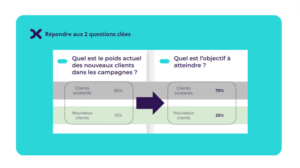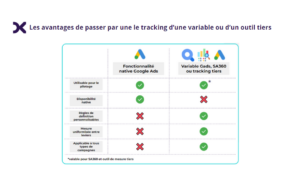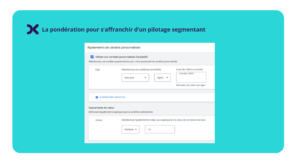Developing a SEA Strategy for Acquiring New Customers

Thibault Druesne, Senior Media Consultant at Converteo, expert in Search topics: He assists our clients in the design, deployment, analysis, and optimization of strategies (organic and paid) on search engines.
In a drive for business growth, companies cannot rely solely on retaining their existing customers. Search engines provide a potential source of consumer intent signals (both online and offline) that must be addressed. It is through the acquisition of new customers that a company grows, which requires a precise methodology dedicated to this objective.
Changes in measurement, new features incorporating increasing automation, and the growing importance of first-party data… recent and upcoming years represent a turning point in how to think about and operate your media acquisition strategies. The recruitment of new customers through SEA is no exception.
To implement a successful SEA customer acquisition strategy, I propose to explore in detail the technical and organizational adjustments we put in place for our clients as part of our missions.
Prepare the Ground
Before launching such a large-scale project, it is fundamental to meet certain prerequisites:
Have a mature SEA account.
- To get the most out of this project, ensure that most of the relevant industry and best practice guidelines are in place in your account: smart bidding strategies, centralization of campaign structures, integration of various audience signals, optimization of text ad quality indicators, and the mandatory fields in your product feed.
Have third-party measurement tools.
- Be able to challenge the data provided natively in SEA buying platforms (Google Ads to date). “New customers” should be identifiable and accounted for according to your own rules in reports or business dashboards.
Communication and engagement of stakeholders.
- Shifting from a historically defensive SEA management approach to more conquest-oriented strategies must be part of a coordinated strategic approach involving media partners and internal teams. Your performance monitoring and analysis perspective is about to evolve; ensure that all key contact points are informed of the upcoming changes to prepare for a smooth transition and anticipate potential challenges.
The most important prerequisite is the definition of clear and quantifiable objectives regarding the desired share of new customers within the overall conversions.
The objectives can be global or segmented according to campaign formats or product categories.

Measurement
Two methodologies exist: native measurement within Google Ads through features dedicated to new customers, and third-party measurement solutions (Google Analytics 4, Search Ads 360, custom variable in Google Ads, etc.), each with its own advantages and disadvantages.
The native feature available in Google Ads allows you to start quickly without additional tag implementation (as long as an active conversion tag is in place and collecting data).
However, the rules for defining a “new customer” are strict and predefined by the platform:
- The user has not made any conversion via the Google Ads tag in the last 540 days.
- The user is not part of the Customer Match audience lists shared within the Google Ads account.
You are therefore dependent on your historical data as well as the match rate between your first-party audiences and the platform.
Using a custom variable through a third-party measurement tool requires setup work (if you don’t already have this data), but it offers a more robust option with two major advantages:
- The ability to measure your new customers across all your acquisition channels.
- The flexibility to define your own rules for triggering a “new customer”:
- Date of last purchase to be considered a “new customer” (e.g., should a user who hasn’t converted in a year be classified as an existing customer in your analysis?).
- Custom criteria: minimum average cart value, specific product types, account creation, etc.

SEA Activations
There are various methods to set up and deploy campaigns aimed at increasing your new customer volume, with each available format on the platform offering potential. Below are some of the most common and effective activations:
The NCA Feature
The most accessible activation is the “NCA” (New Customer Acquisition) feature available within Google Ads (for Text Ads and Performance Max campaigns). It presents two options under the “customer acquisition” settings of your campaigns:
- Set higher bids for new customers compared to existing ones
- Bid only for new customers
The first option requires you to define the estimated value of a new customer for your business. (This value can be adjusted later throughout the campaign.)
Each conversion value from a new customer will be calculated as follows: Order revenue + the defined new customer value. Under these conditions, the algorithm will aim to meet your profitability targets (tROAS).
The algorithm uses this value to determine the intensity with which it should attempt to generate conversions from new customers. The higher this value compared to the average basket, the more existing customers will be deprioritized.
Be aware that using this feature affects the revenue observed in the “conversion value” column, as it now includes the value attributed to new customers for each relevant conversion.
The second option will exclude all Customer Match audiences and users who have already converted via the Google Ads tag within the last 540 days, focusing solely on potential new customers.
I recommend prioritizing the first option because the second requires additional segmentation at the campaign level to target the same product or keyword scope. Beyond the impact on budget management, it’s essential to ensure that the data volumes remain sufficient for analysis, optimization, and the proper functioning of smart bidding strategies.
Capitalizing on Text Ads
The first step is to identify high-potential generic keywords that drive significant traffic. Ideally, these keywords should not be part of your top performers in terms of revenue, CPA, or ROI.
Next, it’s important to define the audience types to target. Based on experience, here are the most effective audiences for this approach:
- In-Market Audiences: Qualified based on your industry.
- Custom Intent Audiences: Associated with competitor search queries (these personalized intent audiences group users based on their previous Google searches, but do not involve purchasing competitor brand names).
- Viewers/Visitors from Social Media or YouTube: Exposed to specific ads or, more broadly, visitors to your site who have not yet converted. It’s beneficial to segment visitors from YouTube or Social Media separately to gain detailed insights into the performance of these specific audiences.
Finally, these audiences should be set to “targeting only” and the campaigns should be monitored using precise indicators (which I will present in the next chapter).
In parallel, I recommend excluding your 1st-party audiences, such as customer lists, from these campaigns to avoid exposing your ads to an unqualified audience.
Product Categorization via Shopping

If you have a product feed and are running dedicated Shopping campaigns, you can label your products based on their potential to attract new customers, allowing you to segment your campaigns using this new categorization.
The goal is to maximize investments on the products with the highest customer acquisition potential while rationalizing your spending on the rest of the catalog.
Lookalike Audiences of Your Customers via Demand Gen
Since the discontinuation of similar audiences in August 2023, the Demand Gen format offers a valuable opportunity to target lookalike audiences based on your customer lists with three different reach options: 2.5%, 5%, and 10%.

The smaller the reach, the more similar the targeted users will be to those within the shared source audiences. However, a larger reach means a higher volume of users to target.
Similar to activations for text campaigns, it is essential to exclude your current customer lists to maximize acquisition efforts and focus solely on qualified prospects.
Adapting Your Management
Adapting your strategy for SEA customer acquisition involves defining new KPIs such as recruitment rate, new customer CPA, volume, or revenue generated solely from new customers.
These indicators should be established and tracked for reporting purposes. Ideally, they are set within the campaigns and account to serve as a basis for performance optimization in dedicated activations.
If modifying all conversion actions for campaign management becomes a hurdle, you can create a custom KPI that distinguishes between revenue from new and existing customers, with a stronger weight given to new customers.
This custom KPI can be built using your analytics or third-party bidding tools, such as Search Ads 360 with its “variable adjustment” feature.

This method allows you to indicate to the bidding tools that new customers are of higher importance while still integrating transactions made by existing customers into decision-making.
There is no “magic” weighting value. Note that a valuation that is too low will have a negligible impact on the weight of new customers, while a valuation that is too high will drastically reduce transactions and revenue generated by existing customers.
The ideal balance may vary depending on the volumes of conversions involved; the key is to test your customized KPI on a small but significant sample of data before considering a large-scale deployment.
Points of Caution
Several points of attention related to the deployment of a customer acquisition strategy in SEA have been shared in the previous sections:
- Performance Evolution: It is impossible to guarantee significant growth in our new customer rate while maintaining the same level of overall performance. Be vigilant to ensure that existing customers are not deprioritized too much within the bidding strategies. It is important to define safeguard KPIs.
- Biased Visibility of Google Ads Performance: If using the native “New Customer Acquisition” feature, keep in mind that the displayed conversion value will take this weighting into account and not just the actual recorded revenue.
- Internal SEA Dynamics: The change in strategy should lead to a shift in how you analyze and optimize your performance. Ensure that all stakeholders are involved from the project’s design phase.

